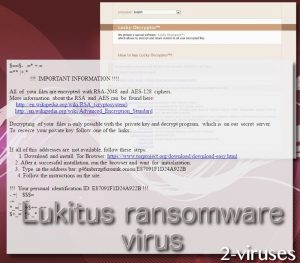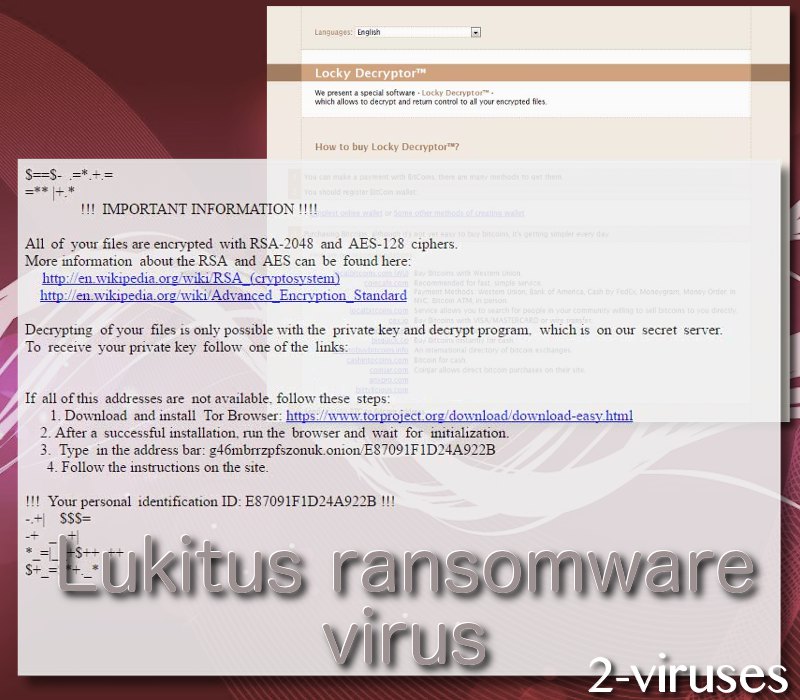Lukitus ransomware virus is another version of Locky infection: its creators have recently been caught occupied with Diablo6 malware as well. The recent variant threatens people and disrupts their operating systems in a very analogous manner, but appends a unique extension of .lukitus. The quickly-spreading Locky virus, controlled by the sharpest hackers, has received approximately 7 million dollars in revenues (Ransomware victims have paid). After returning with the Diablo6 version, it now puts pressure on online surfers by targeting them with malicious .rar attachments in email letters.
The arrival of Lukitus extension definitely triggered a hot reaction for many security experts and portals (Locky is on the rise). The crypto-virus certainly deserves attention as its aggressive nature is threatening basically any online surfer. It has been determined that malspam transmits messages that invite users to take a look at purchase receipts. These letters usually contain .zip or .rar attachments that hide JS files. A few sources of malicious payloads have been determined: Angeldemon.com, Antibody Services.net, Ttytreffdrorseder.net, Asliozturk.com websites. Warning: do not try to enter them for precautionary reasons.
Lukitus Ransomware Virus quicklinks
- The vicious objectives of Lukitus crypto-malware
- Decryption options and elimination of ransomware
- Automatic Malware removal tools
- How to recover Lukitus ransomware virus encrypted files and remove the virus
- Step 1. Restore system into last known good state using system restore
- 1. Reboot your computer to Safe Mode with Command Prompt:
- 2.Restore System files and settings.
- Step 4. Use Data Recovery programs to recover Lukitus ransomware virus encrypted files

(Win)
Note: Spyhunter trial provides detection of parasites and assists in their removal for free. limited trial available, Terms of use, Privacy Policy, Uninstall Instructions,
(Mac)
Note: Combo Cleaner trial provides detection of parasites and assists in their removal for free. limited trial available, Terms of use, Privacy Policy, Uninstall Instructions, Refund Policy ,

The vicious objectives of Lukitus crypto-malware
Lukitus computer virus almost has no differing factors from Locky ransomware (Ransomware FAQ): they both are ready to turn your files into unrecognizable executables that will no longer feature their original filenames nor their extensions. A specific pattern is selected by cyber criminals to disfigure files to the highest level possible.
When selecting unique and confusing filenames for the encoded digital files, malware automatically applies several patterns: [first_8_hexadecimal_chars_of_id]-[next_4_hexadecimal_chars_of_id]-[next_4_hexadecimal_chars_of_id]-[4_hexadecimal_chars]-[12_hexadecimal_chars].lukitus. If you have been keeping track of the activity of Locky, you should have gotten familiar with such samples like ODIN and Zepto ransomware.
When Lukitus crypto-virus will fully complete the encryption process, it will auto-destruct the payload and show several ransom notes to provide information about the requirements hackers have decided to make. Lukitus.bmp and lukitus.htm files load up text, announcing that an operating system has been attacked and digital files from hard drive have been encoded. The message includes an individual personal identification IDs which will be necessary when logging into the TOR website with payment guidelines. An association between TOR and ransomware has been established for quite some time (Relationship between TOR and ransomware).
Currently, the sum that hackers are demanding is 0.46 BTC which translates into 1993.18 US dollars. This ransom can severely hurt your finances and some people might not even have such resources to exploit for purposes of paying a ransom. We hope that you will follow recommendations of security researchers to never pay fees for file-decryption (Before you pay that ransomware demand). Lukitus computer virus is definitely a complicated disease, but there are some slight chance of recovering the data it ruined.
Decryption options and elimination of ransomware
If you have been smart enough to upload your data in backup storages, there is almost no doubt that your files will be properly secured. In case a crypto-malware attacks your operating system, please bear in mind that alternative locations your files is nearly always the only salvation. Occasionally, people can also try to recover Shadow Volume Copies, but this is not always possible due to fact that many ransomware infections take care of these copies.
If you have stored a backup in an online utility or at least an USB flash drive, the chances of getting back your data have just sky-rocked. However, please treat this process carefully. Before implanting files into an operating system, you are bound to eliminate the ransomware. This can be either done manually (follow guidelines below) or with the help of security software. Spyhunter will adequately take care of your system and make sure that similar accidents won’t occur in the future.
One question remains: how did Lukitus ransomware entered your device? It appears, that malicious spam campaigns are selected to transmit this variant. Email messages, containing malicious attachments have been noticed to be the main sources of this infection. Please do not open attachments from unknown senders or explore websites that could be involved in distribution of malware.
Also, keep you remote desktop protocol (RDP) properly secured from unwanted attention. As some ransomware variants exploit these strategies for infiltration. Hopefully, if you are careful enough, your operating system will avoid inconveniences such as this.
Update of the 1st of September, 2017. Lukitus ransomware was transmitted in a gigantic campaign of spam letters. In total, hackers appear to have sent 23 millions of messages, containing payloads of this infection.
We should discuss the latest massive spam campaign that distributed Lukitus ransomware virus (Locky returns with Lukitus). It appears that email letters, containing malware-laden links were pretending to originate from Dropbox: a popular online utility.
As we have already established, the attack lasted for about 24 hours and in this short period of time, an impressive number of malicious letters were sent: 23 million (Locky returns via spam). As you might have already heard of the old Hoefler Text scam pop-up, it has been discovered that this message could bring Locky or its newer version, Lukitus crypto-virus. In addition to this, some voice messages are also determined to be capable of spreading this devastating ransomware sample.
You should remember that Lukitus can be spread through officially-looking websites. For instance, a spam letter, pretending to originate from DropBox, attempts to load a website that looks similarly to the legitimate version. Clicking on dangerous links can have severe consequences. One of them is that you will download a zipped attack file which will contain embedded JavaScript files.
Automatic Malware removal tools
(Win)
Note: Spyhunter trial provides detection of parasites and assists in their removal for free. limited trial available, Terms of use, Privacy Policy, Uninstall Instructions,
(Mac)
Note: Combo Cleaner trial provides detection of parasites and assists in their removal for free. limited trial available, Terms of use, Privacy Policy, Uninstall Instructions, Refund Policy ,
How to recover Lukitus ransomware virus encrypted files and remove the virus
Step 1. Restore system into last known good state using system restore
1. Reboot your computer to Safe Mode with Command Prompt:
for Windows 7 / Vista/ XP
- Start → Shutdown → Restart → OK.
- Press F8 key repeatedly until Advanced Boot Options window appears.
- Choose Safe Mode with Command Prompt.

for Windows 8 / 10
- Press Power at Windows login screen. Then press and hold Shift key and click Restart.

- Choose Troubleshoot → Advanced Options → Startup Settings and click Restart.
- When it loads, select Enable Safe Mode with Command Prompt from the list of Startup Settings.

2.Restore System files and settings.
- When Command Prompt mode loads, enter cd restore and press Enter.
- Then enter rstrui.exe and press Enter again.

- Click “Next” in the windows that appeared.

- Select one of the Restore Points that are available before Lukitus ransomware virus has infiltrated to your system and then click “Next”.

- To start System restore click “Yes”.

Step 2. Complete removal of Lukitus ransomware virus
After restoring your system, it is recommended to scan your computer with an anti-malware program, like Spyhunter and remove all malicious files related to Lukitus ransomware virus. You can check other tools here.Step 3. Restore Lukitus ransomware virus affected files using Shadow Volume Copies
If you do not use System Restore option on your operating system, there is a chance to use shadow copy snapshots. They store copies of your files that point of time when the system restore snapshot was created. Usually Lukitus ransomware virus tries to delete all possible Shadow Volume Copies, so this methods may not work on all computers. However, it may fail to do so. Shadow Volume Copies are only available with Windows XP Service Pack 2, Windows Vista, Windows 7, and Windows 8. There are two ways to retrieve your files via Shadow Volume Copy. You can do it using native Windows Previous Versions or via Shadow Explorer. a) Native Windows Previous Versions Right-click on an encrypted file and select Properties → Previous versions tab. Now you will see all available copies of that particular file and the time when it was stored in a Shadow Volume Copy. Choose the version of the file you want to retrieve and click Copy if you want to save it to some directory of your own, or Restore if you want to replace existing, encrypted file. If you want to see the content of file first, just click Open.
b) Shadow Explorer It is a program that can be found online for free. You can download either a full or a portable version of Shadow Explorer. Open the program. On the left top corner select the drive where the file you are looking for is a stored. You will see all folders on that drive. To retrieve a whole folder, right-click on it and select “Export”. Then choose where you want it to be stored.

Step 4. Use Data Recovery programs to recover Lukitus ransomware virus encrypted files
There are several data recovery programs that might recover encrypted files as well. This does not work in all cases but you can try this:- We suggest using another PC and connect the infected hard drive as slave. It is still possible to do this on infected PC though.
- Download a data recovery program.
- Install and scan for recently deleted files.








